Tourism web of Chinchón (Spain)
Places of interest
Art historical buildings and monuments
Plaza Mayor
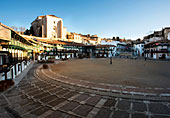
Ranked as one of the most beautiful in world. Meeting place where cattle fairs held, the council bought a house in 1499 to undertake its meetings, establishing the City in the same place that is today.
In 1502 Juana la Loca and Felipe el Hermoso visit Chinchón and our Plaza Mayor. In 1683 was closed, but with enough space to give way to processions and chariots. Taken together, the square is closed by three-storey buildings and wooden balconies, called "claros". It has been used as a comedy theater, in game rods, sacramental celebrations and bullfighting. In 2008 was declared the 4th wonder of the Community of Madrid.
Monasterio de los Agustinos-Parador de Turismo
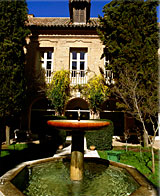
Founded by the Counts of Chinchón in the seventeenth century. During the War of Succession hosted Archduke Carlos during a conference. Over time it became a center of liberal education, during the eighteenth and nineteenth centuries to Mendizábal's disentailment that became the judicial court.
The part that formerly occupied the monks is today the Parador de Chinchon. Attached to the convent is the "Ermita de Nuestra Señora del Rosario", former convent church.
Torre del reloj
Here was located the "Iglesia Parroquial de Nuestra Señora de Gracia", the oldest of Chinchon because it was built the fourteenth century. It was destroyed during the War of Independence, saving only the tower, and that is why there is a popular saying: "Chinchón has a tower without a church and a church without a tower."
The "Torre del reloj" remained standing but throughout history has undergone several restorations. In the first, which took place in the eighteenth century, was placed the clock, but the most important took place in the nineteenth century.
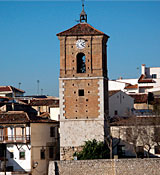
Teatro Lope de Vega
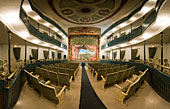
Built on the ruins of the old "Palacio de los Condes", sadly disappeared after the War of Spanish Succession. It has this name because Lope de Vega writes and signs in Chinchon the comedy "El Blasón de los Chaves de Villalba" ("The Blazon of the Chaves from Villalba") when he was staying in the Palace with the Counts of Chinchon.
It was built in 1891 by the Society of Harvesters. The interior houses a fantastic canvas view, allegories of the city, created by Luis Muriel, which serves sometimes as a backdrop.
Castillo de los Condes
Built in the late fifteenth century, but was destroyed in an commoner attack in 1520. The III Count of Chinchon, years later decided to build on the existing foundation of the former. Was well preserved until 1705, when it suffered the consequences of the War of Succession. In 1808 during the three-day siege of Chinchon in the War of Independence, suffered looting and arson.
Since then, some of its materials were used in repairing roads, fences and houses. Its last use was as a liquor factory.

Casa de la Cadena
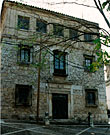
It was the lodging place of King Felipe V, as he passed through Chinchón night February 25, 1706.
It is a baroque building from the late seventeenth century with the orderly facade of three bodies, with access door lintel.
Castillo de Casasola
Built in the fifteenth century, has a triangular floor with a stone bridge and several towers.
It served as accommodation for politics and military pro Alfonso XII. It is Gothic and is now privately owned.
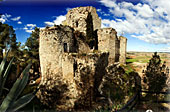
Centro de interpretación

A place that combines historical elements with modern technological aspects and serve to present in a more attractive way all the information content about Chinchón's abundant tourism resources.
It has a projection room, information panels about culture, history, famous people, etc.. Also offers another option: Virtual Chinchón, two computer stations for accessing a virtual model of our city. It also has a central hall where stand temporary photo exhibitions with multiple themed turistic attractions.





